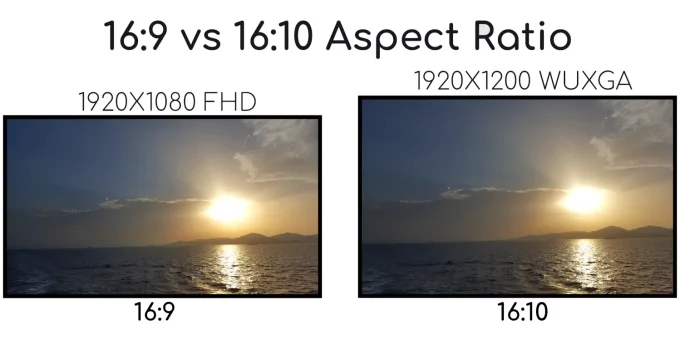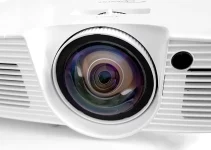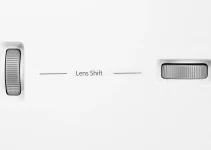The need to understand the comparison between 16×9 vs 16×10 projector screen actually arises from the fact that some projectors have a 16:9 aspect ratio, while others have a 16:10 or even 4:3 aspect ratio.
The easiest way to tell which screen you should get is to check out the aspect ratio for your device. That’s all you have to do.
But you can also check out if your device adjusts the aspect ratio of the projected image. In that case you can go for the very popular 16×9 screens, for which you’ll find various models costing as little as $80-$100 or as much as $600-$700.
The 16×9 is used for gaming and movies, while the 16×10 is more popular for business purposes.
However, I also want to make something clear right from the beginning: most projectors, whether they’re 16:9 or 16:10 originally, can change the aspect ratio of the projected image.
You can choose to change it from 4:3 to 16:9 to 16:10. So, you can safely get a 16×9 screen and change the ratio from the remote control most likely.
Check out my article on what is the best projector screen material if you want to learn even more about projection screens.
Table of Contents
16×9 vs 16×10 Projector Screen Aspect Ratios
16:9 aspect ratio means: 16 units width and 9 units height. It’s almost twice as wide as it is tall. The important thing to remember is that this is the standard for TVs.
16:10 aspect ratio means: 16 units width and 10 units height. It’s not exactly a square but close enough. It’s actually called a widescreen.
Check out my reviews for the best 4K projector screens if you want to find amazing screens for your projector, whether you’re using a device with HD, Full HD or 4K resolution.
16:9 aspect ratio: HD, Full HD and 4K projectors
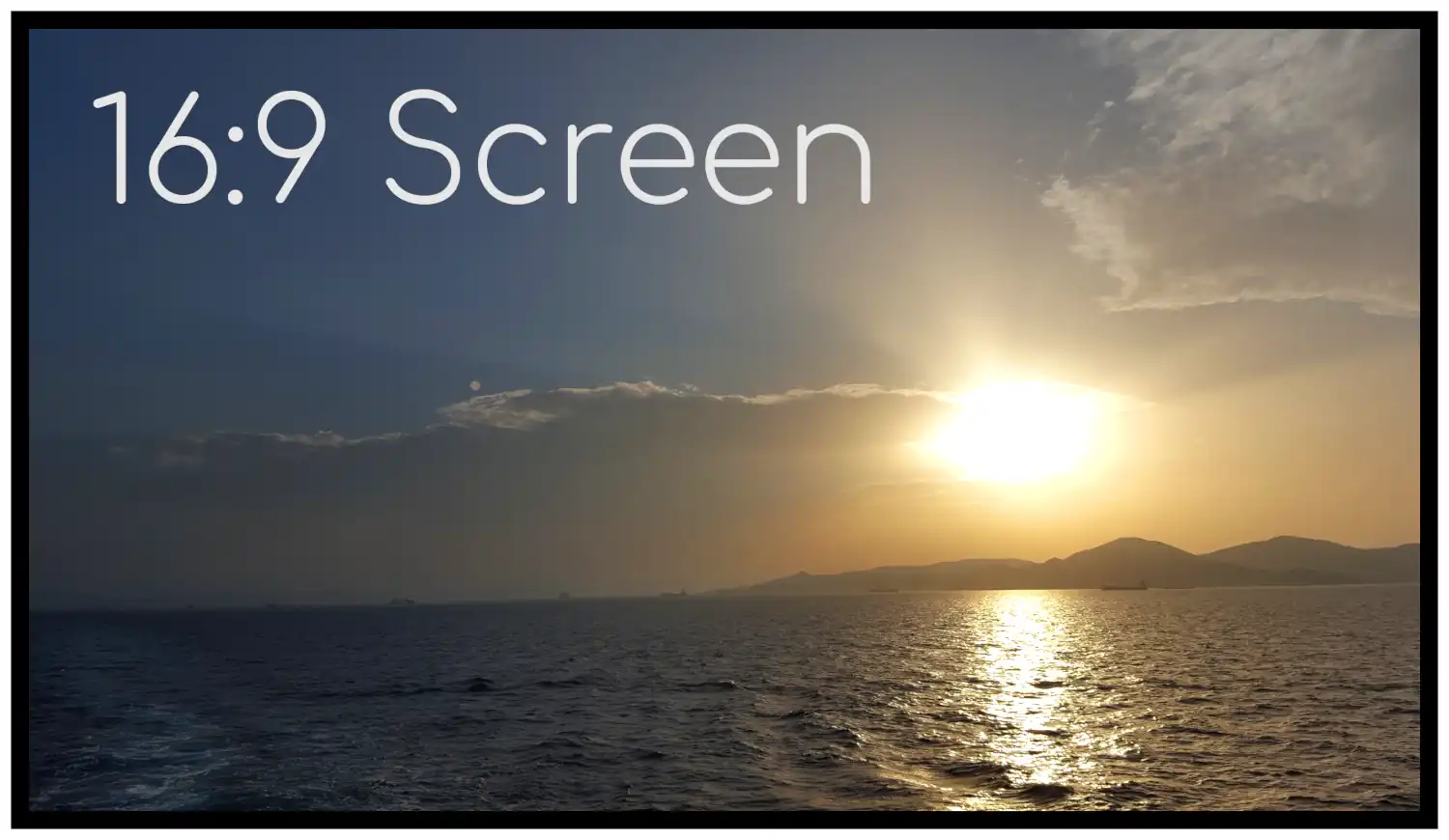
Most projectors have a 16:9 aspect ratio. This is the standard when it comes to watching movies.
Whether you get a 480p, 720p, 1080p or a 4K projector, it will most likely have a 16:9 aspect ratio.
This is the type of screen that most people need to buy.
Moreover, some models include resize support for 16:10 and 4:3. So, there are 16:9 models that can be resized for the other 2 aspect ratios.
16:10 aspect ratio: WXGA, WUXGA, WQXGA and WQUXGA projectors
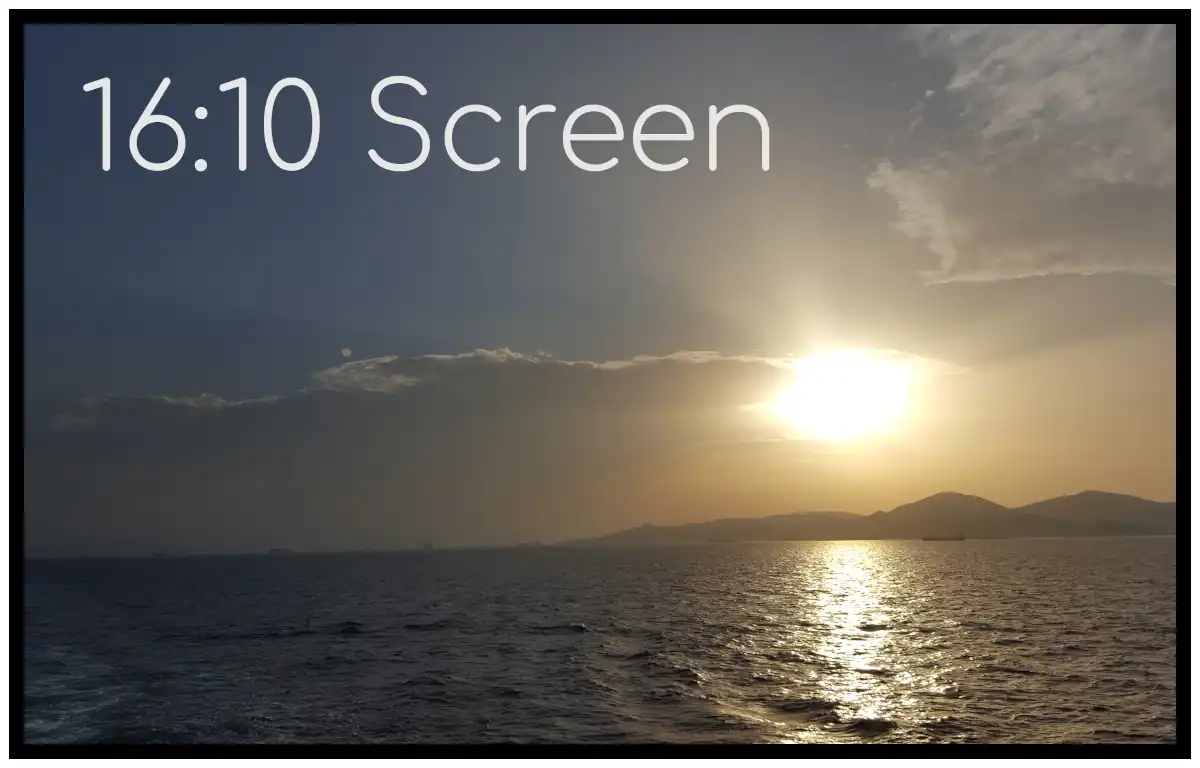
In my article SVGA vs XGA vs WXGA, I actually discuss the fact that these 3 resolutions are different from the more usual resolutions like HD, Full HD, and 4K.
One different feature is that WXGA projectors (1280 x 800 pixels) have a 16:10 aspect ratio. The same goes for a WUXGA projector(1920 x 1200 pixels), it also has a 16:10 aspect ratio.
Other 16:10 projectors are those with WQXGA (2560 x 1600 pixels) and WQUXGA (3849 x 2400 pixels) resolutions.
Another difference is that WXGA models are mostly recommended for business and educational purposes, they’re data projectors and not home theater ones.
WUXGA projectors are mainly used for installation projectors and large venues that require bright, high-definition content.
The advantage with these 4 resolutions is that the focus is put on brightness since data projectors must display clearly in well-light rooms.
Overall, there’s one quick conclusion that we can draw in our 16×9 vs 16×10 projector screen debate: high chances are that most of you are going to need the 16×9 screen.
Using a WXGA/WUXGA laptop/tablet
When it comes to other devices, WUXGA can be used in high-end notebooks (Dell, Asus, Lenovo) and workstation computers. If you’ve ever seen a WUXGA laptop, you’d have noticed how almost square the display looks thanks to its 16:10 aspect ratio.
If you’re connecting a WXGA/WUXGA device to a projector then you still have to choose the type of screen you need based on the aspect ratio of your projector because that’s the device thar projects on the screen and not the laptop/tablet that are connected to it.
4×3 projector screen: SVGA and XGA projectors
SVGA and XGA both have 4:3 aspect ratios and they’re also mainly used for displaying various data (graphics, PowerPoint presentations, spreadsheets, PDF files).
In the case of these two resolutions, a 4×3 projector screen is needed but the good thing is that some are 16:9 compatible or you can adjust the bottom of the screen and still be able to play movies on a 4×3 screen.
Can a projector display a 16×10 image on a 16×9 screen?
Since 16:10 projectors are not that common, 16×10 projector screens are pretty hard to find. There are definitely plenty of 16:9 models starting from about $20 and going way up.
Thus, I would like to answer one important question regarding 16:9 vs 16:10 projector screens: can you use a 16:9 if you can’t find a 16:10 screen?
Of course you can.
However, you must also take into account that a 16×10 offers 20% more horizontal resolution. When you’re displaying on a 16×9 screen you will lose that.
Also, a 16×10 projector screen will feel quite bigger than a 16×9 one. That’s another thing to take into consideration.
In the end, it’s obviously easier to get the right screen for whatever aspect ratio your projector has.
Can you display a 16×9 projector on a 16×10 projector screen?
Yes, you can but I wouldn’t exactly recommend it.
The pixels are more spread out over a larger area, which can lead to less sharpness. It can also cause blurry or distorted images but that’s less likely. A loss in sharpness is the most likely outcome.
It can work if you’re displaying a smaller image than, let’s say, a full 100 inches diagonal screen size.
Plus, you’ll definitely get black lines when watching full HD movies on a 16×10 screen. If you can overcome those, then there’s absolutely no problem. Plus, in a fully dark room, the black lines are not as obvious.
You’ll just have to adjust size until you get a good sharpness.
Still, just as I’ve said above, it would be best if you could get the right screen for your projector.
Each model will indicate its aspect ratio so all you have to do is to check out that spec.
Choosing the right screen for your device ensures that you get the best resolution and the best immersing viewing experience whether we’re talking about presentations, movies or gaming.
16×9 vs 16×10 Projector: Choosing the Right Diagonal Screen Size
There’s another important aspect that we should cover when it comes to 16×9 vs 16×10 projector screens.
Which is the right diagonal screen size? I found a good YouTube video to help with that but I’ll also talk to you about the main takeaways.
That choice is actually influenced by viewing distance.
These recommendations are actually made by SMPTE, which is the Society of Motion Picture and Television Engineers.
Screen size examples
For example, a diagonal screen size of 100 inches (2.5m) should be watched from approximately 11 feet seating distance (about 3.3 meters).
Another popular screen projector size is 120 inches (3m) diagonal, which implies an approximate viewing distance of 13 feet (about 4 meters).
An 80 inches projector screen can be viewed from a distance of about 8-9 feet (approx. 2.5 meters).
Thus, choosing the right projector screen size should be determined after you measure the viewing distance in your room.
100-120 inches screens remain the most prominent and popular. They’re also awesome for the outdoors if you’re organizing movie nights for large crowds. Just maker sure that it has good viewing angles.
For a bigger viewing distance, like 22 feet (6-7 meters), you’ll need a 200 inches (5m) screen diagonal.
Another way to determine the diagonal: the screen height should equal about one-third viewing distance (the distance from the screen to the sitting area). You can find how it’s calculated here. This way of measuring applies to both types of screens be it 16:9 or 16:10.

